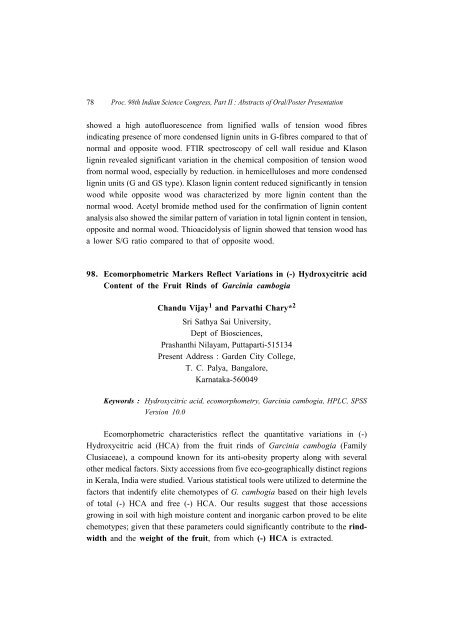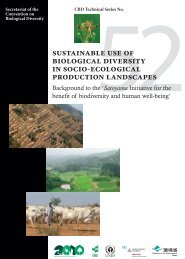INDIAN SCIENCE CONGRESS - India Environment Portal
INDIAN SCIENCE CONGRESS - India Environment Portal
INDIAN SCIENCE CONGRESS - India Environment Portal
You also want an ePaper? Increase the reach of your titles
YUMPU automatically turns print PDFs into web optimized ePapers that Google loves.
78<br />
Proc. 98th <strong>India</strong>n Science Congress, Part II : Abstracts of Oral/Poster Presentation<br />
showed a high autofluorescence from lignified walls of tension wood fibres<br />
indicating presence of more condensed lignin units in G-fibres compared to that of<br />
normal and opposite wood. FTIR spectroscopy of cell wall residue and Klason<br />
lignin revealed significant variation in the chemical composition of tension wood<br />
from normal wood, especially by reduction. in hemicelluloses and more condensed<br />
lignin units (G and GS type). Klason lignin content reduced significantly in tension<br />
wood while opposite wood was characterized by more lignin content than the<br />
normal wood. Acetyl bromide method used for the confirmation of lignin content<br />
analysis also showed the similar pattern of variation in total lignin content in tension,<br />
opposite and normal wood. Thioacidolysis of lignin showed that tension wood has<br />
a lower S/G ratio compared to that of opposite wood.<br />
98. Ecomorphometric Markers Reflect Variations in (-) Hydroxycitric acid<br />
Content of the Fruit Rinds of Garcinia cambogia<br />
Chandu Vijay 1 and Parvathi Chary* 2<br />
Sri Sathya Sai University,<br />
Dept of Biosciences,<br />
Prashanthi Nilayam, Puttaparti-515134<br />
Present Address : Garden City College,<br />
T. C. Palya, Bangalore,<br />
Karnataka-560049<br />
Keywords : Hydroxycitric acid, ecomorphometry, Garcinia cambogia, HPLC, SPSS<br />
Version 10.0<br />
Ecomorphometric characteristics reflect the quantitative variations in (-)<br />
Hydroxycitric acid (HCA) from the fruit rinds of Garcinia cambogia (Family<br />
Clusiaceae), a compound known for its anti-obesity property along with several<br />
other medical factors. Sixty accessions from five eco-geographically distinct regions<br />
in Kerala, <strong>India</strong> were studied. Various statistical tools were utilized to determine the<br />
factors that indentify elite chemotypes of G. cambogia based on their high levels<br />
of total (-) HCA and free (-) HCA. Our results suggest that those accessions<br />
growing in soil with high moisture content and inorganic carbon proved to be elite<br />
chemotypes; given that these parameters could significantly contribute to the rindwidth<br />
and the weight of the fruit, from which (-) HCA is extracted.
















